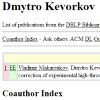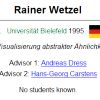| |
 
Philippe Gambette and
Daniel H. Huson. Improved Layout of Phylogenetic Networks. In TCBB, Vol. 5(3):472-479, 2008.
Keywords: abstract network, heuristic, phylogenetic network, phylogeny, Program SplitsTree, software, split network, visualization.
Note: http://hal-lirmm.ccsd.cnrs.fr/lirmm-00309694/en/.
Toggle abstract
"Split networks are increasingly being used in phylogenetic analysis. Usually, a simple equal-angle algorithm is used to draw such networks, producing layouts that leave much room for improvement. Addressing the problem of producing better layouts of split networks, this paper presents an algorithm for maximizing the area covered by the network, describes an extension of the equal-daylight algorithm to networks, looks into using a spring embedder, and discusses how to construct rooted split networks. © 2008 IEEE."
|
|
| |
 
Tobias Kloepper and
Daniel H. Huson. Drawing explicit phylogenetic networks and their integration into SplitsTree. In BMCEB, Vol. 8(22), 2008.
Keywords: explicit network, phylogenetic network, phylogeny, Program SplitsTree, software, split network, visualization.
Note: http://dx.doi.org/10.1186/1471-2148-8-22.
Toggle abstract
"Background. SplitsTree provides a framework for the calculation of phylogenetic trees and networks. It contains a wide variety of methods for the import/export, calculation and visualization of phylogenetic information. The software is developed in Java and implements a command line tool as well as a graphical user interface. Results. In this article, we present solutions to two important problems in the field of phylogenetic networks. The first problem is the visualization of explicit phylogenetic networks. To solve this, we present a modified version of the equal angle algorithm that naturally integrates reticulations into the layout process and thus leads to an appealing visualization of these networks. The second problem is the availability of explicit phylogenetic network methods for the general user. To advance the usage of explicit phylogenetic networks by biologists further, we present an extension to the SplitsTree framework that integrates these networks. By addressing these two problems, SplitsTree is among the first programs that incorporates implicit and explicit network methods together with standard phylogenetic tree methods in a graphical user interface environment. Conclusion. In this article, we presented an extension of SplitsTree 4 that incorporates explicit phylogenetic networks. The extension provides a set of core classes to handle explicit phylogenetic networks and a visualization of these networks. © 2008 Kloepper and Huson; licensee BioMed Central Ltd."
|
|
| |
  
Steven M. Woolley,
David Posada and
Keith A. Crandall. A Comparison of Phylogenetic Network Methods Using Computer Simulation. In PLoS ONE, Vol. 3(4):e1913, 2008.
Keywords: abstract network, distance between networks, evaluation, median network, MedianJoining, minimum spanning network, NeighborNet, parsimony, phylogenetic network, phylogeny, Program Arlequin, Program CombineTrees, Program Network, Program SHRUB, Program SplitsTree, Program TCS, split decomposition.
Note: http://dx.doi.org/10.1371/journal.pone.0001913.
Toggle abstract
"Background: We present a series of simulation studies that explore the relative performance of several phylogenetic network approaches (statistical parsimony, split decomposition, union of maximum parsimony trees, neighbor-net, simulated history recombination upper bound, median-joining, reduced median joining and minimum spanning network) compared to standard tree approaches (neighbor-joining and maximum parsimony) in the presence and absence of recombination. Principal Findings: In the absence of recombination, all methods recovered the correct topology and branch lengths nearly all of the time when the subtitution rate was low, except for minimum spanning networks, which did considerably worse. At a higher substitution rate, maximum parsimony and union of maximum parsimony trees were the most accurate. With recombination, the ability to infer the correct topology was halved for all methods and no method could accurately estimate branch lengths. Conclusions: Our results highlight the need for more accurate phylogenetic network methods and the importance of detecting and accounting for recombination in phylogenetic studies. Furthermore, we provide useful information for choosing a network algorithm and a framework in which to evaluate improvements to existing methods and novel algorithms developed in the future. © 2008 Woolley et al."
|
|
| |
   
James B. Whitfield,
Sydney A. Cameron,
Daniel H. Huson and
Mike Steel. Filtered Z-Closure Supernetworks for Extracting and Visualizing Recurrent Signal from Incongruent Gene Trees. In Systematic Biology, Vol. 57(6):939-947, 2008.
Keywords: abstract network, from unrooted trees, phylogenetic network, phylogeny, Program SplitsTree, split, split network, supernetwork.
Note: http://www.life.uiuc.edu/scameron/pdfs/Filtered%20Z-closure%20SystBiol.pdf.
|
|
| |

Tobias Kloepper. Algorithms for the Calculation and Visualisation of Phylogenetic Networks. PhD thesis, Eberhard-Karls-Universität Tübingen, Germany, 2008.
Keywords: from rooted trees, from sequences, from unrooted trees, galled network, phylogenetic network, phylogeny, Program SplitsTree, reconstruction, split network, visualization.
Note: https://publikationen.uni-tuebingen.de/xmlui/handle/10900/49159.
|
|
| |
   
Stefan Grünewald,
Andreas Spillner,
Kristoffer Forslund and
Vincent Moulton. Constructing Phylogenetic Supernetworks from Quartets. In WABI08, Vol. 5251:284-295 of LNCS, springer, 2008.
Keywords: abstract network, from quartets, from unrooted trees, phylogenetic network, phylogeny, Program QNet, Program SplitsTree, reconstruction, split network.
Note: http://dx.doi.org/10.1007/978-3-540-87361-7_24.
Toggle abstract
"In phylogenetics it is common practice to summarize collections of partial phylogenetic trees in the form of supertrees. Recently it has been proposed to construct phylogenetic supernetworks as an alternative to supertrees as these allow the representation of conflicting information in the trees, information that may not be representable in a single tree. Here we introduce SuperQ, a new method for constructing such supernetworks. It works by breaking the input trees into quartet trees, and stitching together the resulting set to form a network. The stitching process is performed using an adaptation of the QNet method for phylogenetic network reconstruction. In addition to presenting the new method, we illustrate the applicability of SuperQ to three data sets and discuss future directions for testing and development. © 2008 Springer-Verlag Berlin Heidelberg."
|
|
| |
  
Gabriel Cardona,
Francesc Rosselló and
Gabriel Valiente. Extended Newick: It is Time for a Standard Representation. In BMCB, Vol. 9:532, 2008.
Keywords: evaluation, explicit network, phylogenetic network, Program Bio PhyloNetwork, Program Dendroscope, Program NetGen, Program PhyloNet, Program SplitsTree, Program TCS, visualization.
Note: http://bioinfo.uib.es/media/uploaded/bmc-2008-enewick-sub.pdf.
|
|
|
 - forked on GitHub.
- forked on GitHub.

















































